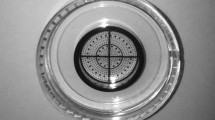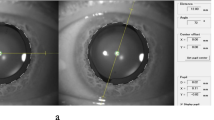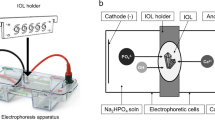Abstract
Purpose
To evaluate the rotational stability of the Acrysof Toric intraocular lens (IOL) after experimental eye trauma.
Methods
Two human cadaver eyes were prepared in accordance with the Miyake–Apple technique, with closed-system modification. After phacoemulsification, an Acrysof Toric IOL was implanted in the capsular bag. Experimental traumatisation of the globe was achieved by pressing against the eye wall using a cotton tip or a fingertip, whereas the IOL was observed from the posterior view. Digital photographs of the eye before and after the procedures were overlaid to detect and measure rotation of the IOL.
Results
The IOL rotated 5.80° when the traumatic procedures did not cause important leakage from the incision. When the traumatic procedures caused important leakage from the incision and anterior chamber collapse, the IOL rotated 41.00°.
Conclusion
Ocular trauma can cause rotation of the Acrysof Toric IOL. In the event of an eye trauma with no or insignificant leakage from the incision, the IOL rotates less than when the trauma causes significant leakage from the incision.
Similar content being viewed by others
Log in or create a free account to read this content
Gain free access to this article, as well as selected content from this journal and more on nature.com
or
References
Davis BL, Nilson CD, Mamalis N . Revised Miyake-Apple technique for postmortem eye preparation. J Cataract Refract Surg 2004; 30 (3): 546–549.
Auffarth GU, Wesendahl TA, Solomon KD, Brown SJ, Apple DJ . A modified preparation technique for closed-system ocular surgery of human eyes obtained postmortem: an improved research and teaching tool. Ophthalmology 1996; 103 (6): 977–982.
Patel CK, Ormonde S, Rosen PH, Bron AJ . Postoperative intraocular lens rotation: a randomized comparison of plate and loop haptic implants. Ophthalmology 1999; 106 (11): 2190–2195.
Viestenz A, Seitz B, Langenbucher A . Evaluating the eye′s rotational stability during standard photography: effect on determining the axial orientation of toric intraocular lenses. J Cataract Refract Surg 2005; 31 (3): 557–561.
Author information
Authors and Affiliations
Corresponding author
Additional information
Sources of public and private financial support: Intraocular lenses provided by Alcon Laboratories, Sydney, Australia.
Financial interest: None.
This work was presented as a film on the Australasian Society of Cataract and Refractive Surgeons (AUSCRS) Annual Meeting, Coolum, Australia, June 2008, and on the 40th Annual Scientific Congress of the Royal Australian and New Zealand College of Ophthalmologists (RANZCO), Melbourne, Australia, November 2008.
Conflict of interest
The authors declare no conflict of interest.
Rights and permissions
About this article
Cite this article
Pereira, F., Milverton, E. & Coroneo, M. Miyake–Apple study of the rotational stability of the Acrysof toric intraocular lens after experimental eye trauma. Eye 24, 376–378 (2010). https://doi.org/10.1038/eye.2009.150
Received:
Revised:
Accepted:
Published:
Issue date:
DOI: https://doi.org/10.1038/eye.2009.150



